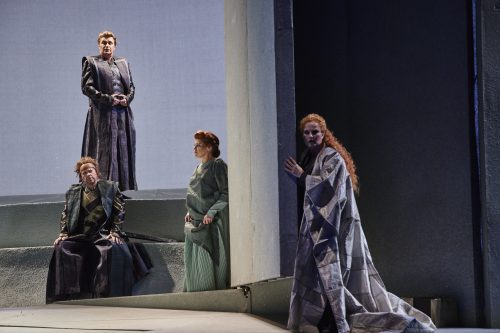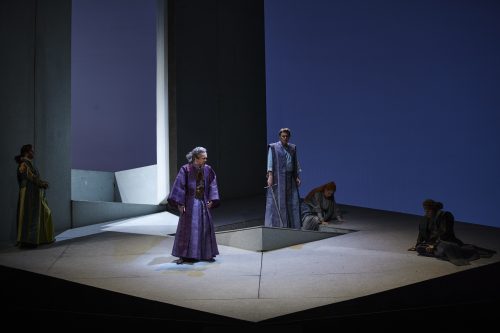 Germany Wagner, Tristan und Isolde: Soloists, Sächsischer Staatsopernchor Dresden, Sächsische Staatskapelle Dresden / Christian Thielemann (conductor). Semperoper Dresden, 21.1.2024. (DMD)
Germany Wagner, Tristan und Isolde: Soloists, Sächsischer Staatsopernchor Dresden, Sächsische Staatskapelle Dresden / Christian Thielemann (conductor). Semperoper Dresden, 21.1.2024. (DMD)

Production:
Director and Sets – Marco Arturo Marelli
Costumes – Dagmar Niefind-Marelli
Lighting – Friedewalt Degen
Stage music – Alexander Bülow
Dramaturgy – Hella Bartnig
Chorus director – André Kellinghaus
Cast:
Tristan – Klaus Florian Vogt
Isolde – Camilla Nylund
King Marke – Georg Zeppenfeld
Kurwenal – Martin Gantner
Brangäne – Tanja Ariane Baumgartner
Melot – Sebastian Wartig
Shepherd / Young Sailor – Attilio Glaser
Helmsman – Lawson Anderson
Wagner saw his work as Gesamtkunstwerk, a unity of stage design, costumes, lighting, acting, music and singing; for all those component parts to be of equal importance and to merge into unified experience for the spectator. In all my experience as spectator, the performance of Tristan und Isolde at the Semperoper Dresden came closest to achieving this ideal, thus taking it to a new level.
This timeless production was created in 1995. The set consists of a simple cube, not in parallel with the ramp but with one of its angles pointing like an arrow at the conductor. While this cube is at first on an even plane it is subsequently raised at the back, creating a slope. The walls on the left and right side of the cube provide tall doorways of different widths. A gauze encircles the cube for Act II, falling to the ground when Tristan and Isolde are discovered by King Marke. The imaginative lighting design creates landscapes of slowly varying colours projected against the walls, the floor and the gauze. The characters wear flowing robes, which renders them statuesque.
The size of the stage, the height of the walls and the doorways within them, the colour projections and those statuesque characters fit the grandeur of the music as performed by the musicians and singers under Christian Thielemann’s conducting. The instruments in each section play at an exceptionally high level of unison, which allows the interplay of sections to come to the fore with striking clarity and this is mirrored somewhat by the interweaving of colours and the undulating costumes. Thielemann can create a sound that genuinely combines orchestral playing and singing. They no longer sound merely in parallel to each other, more or less arbitrary in their relations, with random moments when one can be heard more than the other or vice versa. Here the voices become part of the score, or the score becomes part of the singing – they become one. Thielemann leads his orchestra in such a subtle manner, the musicians are so alert, aware, open, and ready to do what he asks them to do at any point throughout the entire performance that a unique unity of music and human voice is created. My mode of experiencing time changed dramatically and I was entirely unaware of time passing: the conventional sequential unfolding of the impressions of sound and visual stimuli merged into one, transcending time.
Such an achievement is possible only on the basis of an exceptional level of rapport between musicians and conductor, combined with the presence of exceptional singers. For Camilla Nylund, this was the second production in which she sang Isolde – following her relatively recent debut in this role in Zürich in 2022 (review here). She now inhabits the character fully, both in terms of her acting and her singing, and is in full control and command of her voice, trusts it inherently, enjoys it, relishes it. Thielemann gives the music for her lines precisely the volume, depth and density it needs for music and voice to resonate as one. The rendering of Isolde’s Liebestod, ‘Mild und leise’, became, in its soaring lines of melody, both a natural summary and the inescapable climax of the opera, as never before.

Klaus Florian Vogt gave his role debut as Tristan in this performance. Many passages of the role have been described by critics and music theorists as difficult; they have indeed sounded like hard work for many notable tenors. When tenors manage to brave the difficulties without audible problems, comments on their performance would invariably relate to sturdiness or stamina. Those concepts and the related terminology do not do justice to Vogt’s Tristan. This debut comes at the right time for his voice which he has developed over the years with great and loving care. As a result, the voice allows Vogt to actually – and literally – ‘sing’ the part of Tristan, throughout, without any exception. The voice never sounds forced, pressed, squeezed, narrow or strained. He sings gently and lyrically where appropriate and there is vocal abandon when necessary. With ease – and in full control of his vibrato – Vogt joins the orchestra, leads the orchestra or even overrides the orchestra in the louder passages.
Thielemann gave Georg Zeppenfeld as King Marke the space he needed to bring out the best in his voice. Very nuanced and with keen awareness for phrasing, his rendering of Marke’s shades of sadness was very moving indeed. Martin Gantner took inspiration from the leads and trusted the music Wagner had composed for Kurwenal: the words are enough to show he is rougher in nature than Tristan and Gantner sang the music beautifully with a well-focused voice and so did not sacrifice any beauty to match his character. Tanja Ariane Baumgartner offered a Brangäne who was an independent woman, sung with a well-rounded, rich voice. Sebastian Wartig as Melot, Lawson Henderson as the Helmsman (both company members of the Semperoper) and Attilio Glaser (company member at Deutsche Oper Berlin, with a recent role debut as Lohengrin) as Shepherd and Young Sailor have strong voices in their own right and contributed well to a production that is exceptional overall.
Daniel Meyer-Dinkgräfe
Featured Image: Klaus Florian Vogt (Tristan) and Camilla Nylund (Isolde) © Semperoper Dresden/Ludwig Olah
